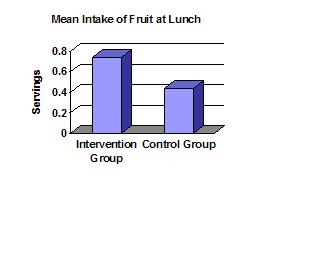Program Synopsis
Designed to increase fruit and vegetable consumption among fourth- and fifth-grade students, this school-based intervention has four components: behavioral curricula, parental involvement/education, school food service changes, and industry involvement and support. The study showed an increase in fruit and vegetable consumption.
Program Highlights
Program Materials
Preview or download materials
Program Scores
The Need
Eating a diet high in fruits and vegetables reduces the risk for future development of cancer, heart disease, and stroke, the three leading causes of death among Americans. Five daily servings of fruits and vegetables are recommended for persons over the age of two years. Yet, only 32% of adults and 16% of children get the recommended number of servings. Nutrition programs hold promise in promoting healthful behaviors among children because dietary patterns appear to be established in childhood and adolescence. In particular, school-based interventions can help children and adolescents form positive health behaviors that may last into adulthood, thereby reducing disease risk in the years to come.
The Program
5-a-Day Power Plus is a school-based, multi-component intervention aimed at increasing fruit and vegetable consumption among fourth- and fifth-grade students. The program seeks to increase fruit and vegetable consumption by concurrently affecting behavior change in the school, the home, and the community environment. As such, the program has four components: 1) behavioral curricula for fourth and fifth grade students, 2) parental involvement/education, 3) school food service changes, and 4) industry involvement and support. Designed expressly for school delivery, the program also incorporates elements of learning, including reading, writing, math, oral presentation, and goal setting.
Time Required
The 5-a-Day Power Plus program includes two curricula, "High 5" for fourth grade and "5 for 5" for fifth grade. Each curriculum includes 16 sessions, 40-45 minutes per session, taught twice per week for 8 weeks. Teachers attend a 1-day training session, and food service staff attend a 2-hour training session.
Intended Audience
The program was tested with 4th- and 5th-graders from elementary schools in St. Paul, Minnesota; 48% were White, 25% were Asian-American (largely Hmong), 19% were African American, 6.4% were Hispanic and 1.3% were Native American. More than 60% of the students received free or reduced-cost lunches.
Suitable Settings
This intervention is intended for implementation in the elementary school.
Required Resources
The 5-a-Day Power Plus 4th-and 5th-grade curricula which include all teacher, student and parent materials are required. The teacher and food service training manual is also required. Cafeteria line posters for 4th and 5th grade are recommended, but not required. Estimated costs to implement the program are approximately $8 - $10 per student, including costs for student, family and teacher materials and for the food for the classroom taste testing/snack preparation sessions.
About the Study
Twenty low-income, ethnically diverse, inner city elementary schools in St. Paul, Minnesota were matched and then randomly assigned to either the 5-a-Day Power Plus program or to a control group. Fourth-and fifth-grade students in the treatment group received an 8-week curriculum which included sixteen 40- to 45-minute classroom sessions. Parental involvement, food service, and industry components supported and reinforced the classroom intervention. The school curricula included skill building and problem solving activities, snack preparation, and taste testing; the family component involved information/activity packets (4th grade) and snack packs (5th grade) to prepare at home; the food service intervention included point-of-purchase promotion of fruits and vegetables, enhancement of the attractiveness of fruits and vegetables, increasing the variety and choice of fruits and vegetables in the cafeteria, and providing additional fruit and vegetable options on days when baked desserts are served; the final component, industry support, involved the recruitment of local food industries to donate food, educational materials and presentations to the intervention program.
Results indicated:
- Based on lunchroom observations, intervention students consumed more combined fruits and vegetables (.47 servings) and fruit (.30 servings) at lunch than control students. Intervention girls also increased lunchtime consumption of vegetables compared to control girls.


- Based on 24-hour recall, intervention students consumed more fruits daily and consumed less fat than control students.
- Based on self-report, intervention students perceived more teacher support for eating fruits and vegetables, had greater perceived need to eat fruits and vegetables, more often reported requesting fruits and vegetables, and consumed more daily servings of fruits and vegetables than students in the control group.
Publications
Taylor G, Foerster SB, DiSogra L. (2000). Effective Behaviour Change in Community Environments: Children in School. In Stables G, Farrell M (Eds.), 5 A Day International Symposium Proceedings. Wallingford, Oxon, United Kingdom: CABI Publishing International.
Kirby SD, Baranowski T, Reynolds KD, Taylor G, Binkley D. (1995). Children's Fruit and Vegetable Intake: Socioeconomic, Adult-Child, Regional, and Urban-Rural Influences. Journal of Nutrition Education, 27 (5), 261-271.
Havas S, Heimendinger J, Damron D, Nicklas TA, Cowan A, Beresford SAA, Sorensen G, Buller D, Bishop D, Baranowski T, Reynolds K. (1995). 5 A Day for Better Health - Nine Community Research Projects to Increase Fruit and Vegetable Consumption. Public Health Reports, 110 (1), 68-79.


